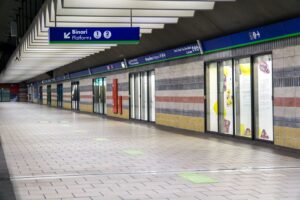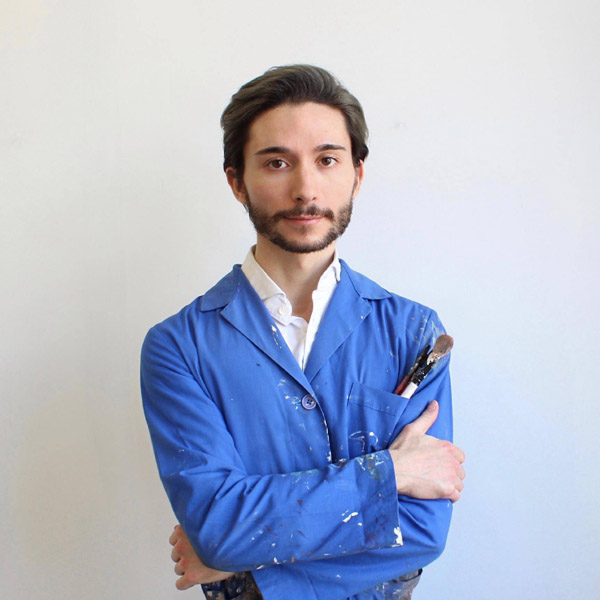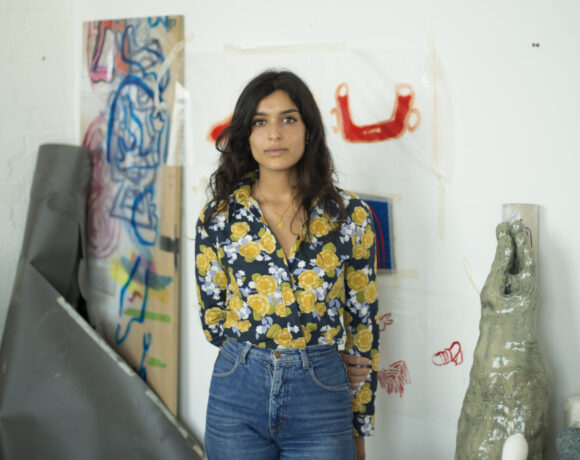Co_atto is a project space, hosted in the Porta Garibaldi railway station in Milan, which has all the characteristics of an art festival at large. We asked curator Marta Orsola Sironi, one of the founders of the project, about the first exhibition of co_atto, in_festa. We found out much more, especially about how the non-profit art scene in Milan has developed new exhibition strategies during the pandemic.
Co_atto is an exhibition project, developed during the months of the second wave of the pandemic in Italy and Milan. It is a project space hosted in an unusual setting, a railway station, but also much more than that. What is it about, and how did the project start, and why?
Co_atto was born in October, created by four different personalities: Ludovico Da Prato, urban planner and architect; Stefano Bertolini, designer and street artist; Daniele Miglietti, musician, writer, as well as lawyer and street artist; and myself, a curator and an art historian. It all started thanks to a mutual friend, Vincenzo Argentieri, a curator, himself based in Milan, who already managed an independent space, in partnership with Artepassante: an urban redevelopment project, which also co_atto belongs to. It is thanks to Daniele Miglietti, then, that we all four met. All of us had the common goal of developing a long-term exhibition project, alternative to the dynamics of the official art world in town, as we know it. A space where to plan a solid and long-term exhibition project, inspired by research-based artistic practices, as well as different disciplines. Daniele, Stefano and Ludovico had more or less this same will, even though they came from different backgrounds than mine.
The exhibition project is part, as you mentioned, of a pre-existing urban redevelopment project, Artepassante. What is it about?
Co_atto, like spazioSERRA, is part of Artepassante: a redevelopment project that uses different stations of the Milan railway network, with the main goal of promoting emerging artists. Underpass is part of the DisseMIna Project, promoted by Le Belle Arti APS – Artepassante Project, and funded by the Cariplo Foundation’s call for proposals “Places of cultural innovation – 2019”. Artepassante was the ideal platform where to nestle co_atto. We had eighteen shop windows at our disposal, on the mezzanine floor of the Porta Garibaldi railway station. Each window measures four meters in length, one meter and eighty in height, and it is fifty centimetres deep. They are very large, but very narrow, within a rather impressive corridor.
Artepassante was therefore a pre-existing reality. Were you the first ones to make exhibitions in the windows, or did you continue using them that way?
Previously, the shop windows hosted group exhibitions, always organised under the aegis of Artepassante. At that time, the windows were just advertising spaces. When we took over, we felt the need of visually “colonise” the space: on the one hand, we wanted to make people forget the previous commercial function of the windows; on the other hand, we wanted to keep using that function. In_festa, our first exhibition, to this extent, presents our goal, as organisers, to claim a space of visibility for the artists. We wanted to use the space differently from its previous use, merely dedicated to commercial advertising. Although, when we planned the exhibition, there was a past that we wanted to keep referencing, albeit with the desire of starting again from scratch.
From scratch, yet, within a pathway already started?
Yes, for sure: a continuity, due to the fact that co_atto takes place within Artepassante; yet, we prefer to give space to installations and site specific projects. The site-specific, installation-based characteristic is key for us. Even when it comes to painting, we want to colonise the space in its totality. This is because even a small depth, of just about fifty centimetres, invites the viewer to rethink full and empty spaces in an alternative way, differently from standard installation practices in more traditional exhibition spaces. We want to fill the void between the viewer and the exhibiting wall inside the vitrine, which can also be almost annoying, and perceived as a limit. Yet, this is also a potential.
You all four have different personalities and background. How this versatility influences your work together?
Co_atto is the result of a meeting of four different professionals. I am a curator, an archivist, an art historian, a social media manager, and my colleagues have different backgrounds and work experiences. We did not want to create another exhibition space, there is plenty of them in Milan. They work well, and I keep collaborating with some of them. We wanted to create something that embraced the multi-disciplinary nature that belongs to each of us, making it our strength: we therefore decided that co_atto will always have a multi-disciplinary approach, with no personal exhibitions. Where we will organise solo shows, we will invite the artist to work as a curator.
A real exhibition, but also a digital platform. In times of viewing art rooms, massively grown since the start of the pandemic. How important is the online presence of your project?
In_festa has been programmed due to the need of creating an exhibition within shop windows, which are “covid-free” spaces, in a moment where we all were permanently shut at home, while digital events and exhibitions massively proliferated. We therefore started in January, also to respond to the pervasive presence of online art projects. However, we see digital as a parallel presence, rather than a priority. We will never do digital openings, instead of an exhibition. The digital world remains an accessorial space, the exhibition project always comes first. All co_atto events are extended into a series of parallel projects, both online and onsite, according to our possibilities.
For art galleries, during the last year, the only visible space has been, for a certain time, just the window: almost a symbolic space of the”offline” art world, but also a space of resistance. What does this place represent for you?
The window has become, for us, not only an exhibition space, but also a place for mutual exchange, with other art spaces in Milan.
For many non-profit and commercial art spaces, the window remains a trademark, within the public space. At the same time, the windows of co_atto are located in a so-called non-place, where people pass by along their journey. How do you relate to such characteristics of the station?
The passante at Porta Garibaldi is a “democratic” space, and for this reason, it is also challenging. The three possible meanings of the Italian word co_atto, to this extent, recalls different aspects of the project. “Coatto”, like the vernacular term used in Rome, is used almost ironically, in contrast with a certain haughtiness we often associate to the art world. On the other hand, coatto refers to the idea of coercion: in our case, the coerced passage of the passers-by in the station, next to our windows, along a rigid perspective. Coatto refers also to the idea of co-action, since we ask the public to participate to our programme, in multiple ways. Co_atto is an exhibition, but also a process of meaning. This is also because we work with multiple disciplines and professionals.
I imagine that your audience is that of art lovers, but not only that. What feedbacks from the public have you had so far?
We soon realised that people from very different background and lifestyles cross their pathways at the station. This, in a more conventional art space, happens to a lesser degree. At the station of Porta Garibaldi we see the inhabitants of Milan’s suburbs, of the Isola district, rather than the fashion victims of Corso Como, or the professionals of Piazza Aulenti, pass by. This is a different audience. A clear example of such diversity is provided by the reactions to one of our projects: the window show by Crates, created by designer Vlad Chetrusca and artist Matteo De Nando, which offers logistics and shipping services. One of their prototype for shipping crates refers to a film by Italian comic trio Aldo, Giovanni and Giacomo, “Three men and a leg”, as well as to the film “Vacanze Intelligenti”, with Alberto Sordi. Initially, Crates wanted to cover the window, but they soon realised that their references to the films were easily recognisable by many passers-by, and they chose to leave the window clearly visible.
Are there, right now in Milan, other art projects similar to co_atto?
There are several, such as Superfluo, with which we collaborate. There is spazioSERRA, developed inside the same aegis of Artepassante, which, like co_atto, is located in a passageway inside the RFI stations. There is State Of_, which combines art and fashion. There is Casa Cicca Museum, with an artist-in-residence and multi-disciplinary programme, which will soon open its third location. There is also the artist-run space Brace Brace, represented at in_festa by Hund studio, and Cecilia Mentasti, one of its founders. They too develop an ongoing project along with artists, almost with a solo show. With co_atto we cannot work in the same way; the twenty-four creative identities involved for in_festa, for example, correspond to forty-nine people. However, we think of our shop windows as artist’s residences, yet in a time frame that is shorter than usual residences. Our programme consists of a research developed in a team, which identifies a common topic. The shop windows becomes, then, the place where such meeting happens and develops: a space dedicated to encounter and exchange. We strongly believe in the power of collective collaboration. No one is saved alone, together is always better. For this reason co_atto works also with other art spaces and projects. In September we would like to create, for the Design week and the Art Week, a festival that involves all the realities we work with.
Along with the physical exhibition, you have also made a publication. What is it about?
Co_atto has a fanzine, red_atto: a blog updated on a weekly basis, which involves collaborators from different disciplines: from the artist to the biologist, from the philosopher to the neuroscientist. Each of them think of a different theme, for each publication. If in_festa is, for example, a real, as well as symbolic infestation, the theme of red_atto is now such idea of infestation, seen as a colonisation of a closed place, where new possibilities can take place. The fanzine will be printed at the end of the exhibition, with the full collection of articles, in collaboration with independent publishing projects. We would also like to have an archive, conceived as a process-based exhibition. Our second exhibition will focus exactly on that: the archive, with four visual artists, and related collateral events. Since we have just started our archive, we thought, while waiting for it to grow, to make a window available to an editorial project; for in_festa, the window has been given to 5X Letterpress and Libri Finti Clandestini. It is always a mutual exchange. We wanted to let the public think of the windows like web pages. Satellite events seem to stem from our site-specific project, like further links, more or less related to one another.
Your project has clearly the features of an art biennial.
Yes, co_atto has all the characteristics of an art festival. For each exhibition we have a window for our archive, dedicated this year to independent publishing houses, and publications. Then we have a showcase dedicated to photography, for which we ask a photographer, each time a different one, to interpret the current exhibition. Finally, we have a series of collateral events, online and on site.
The shop window is generally a modular space, apparently neutral, not too far from the white cube, from the gallery. The site-specific aspect you work with seems to extend itself, to a certain degree, to both the inside and the outside, the glass being a threshold. How did you relate to a certain neutrality, or, differently, to a certain peculiarity of such space?
To tell the truth, the windows are very peculiar. They are visually divided into four sections, even if they have no interruptions inside. It is as if the gaze is broken up by such configuration. And it is very difficult to forget the windows itself. This can also be a potential: for example, with the intervention of Francesco Pacelli, who wanted to play with the perception of light and colour, the window was painted in purple. It was as if the window was dematerialised, but up to a certain degree. Its structure is more visible, however, when we exhibit paintings. Other artists worked differently. Cecilia Mentasti filled the window with steam, and wrote a sentence on the glass. There is a photo of such moment, a window within the window. SerT, a cartoonist, has created a four-panel strip, with the shape of the outer lines of the window, creating an almost trompe-l’oeil effect. PiskV, a street artist, invited by Nubifilm, a group of video-makers, has created a live painting, made with augmented reality, in the space two days. The resulting video by Nubifilm, about the anxieties and nightmares during the pandemic, can be seen with a QR code. The result is an interaction between the physical rhythm of the window and the rhythm of the work, with vertical bars represented in painting, which reflect the hinges of the window.
Did you also consider performance as an art form for the project, despite the limits imposed by the space? Even if the execution of a street-art project is a performance itself?
We are very interested about street art. We will make a street-art exhibition in the future, with an overview of the Roman and the Milanese graffiti scenes. The performative aspect has been actually very present in co_atto, like the live-painting by PiskV, or the work of Cecilia Mentasti, even if they are not defined as works of performance art by the artists themselves; yet, they are still performative events. Other installations intersect with performance. Hund’s project, referencing the loss of leisure activities during the pandemic, is actually a gym. Every now and then, spontaneously, the window is used as a space for yoga sessions. A re-appropriation of a place, now dedicated to self care. These are veiled performances. We also have videos and digital installations. For the closing day of in_festa, scheduled for May 7th, we will have a live of the singer Ponee, whose identity is taken care of by Superfluo project. Together with SerT, cartoonist, if public measures will make it possible, the two will have a live-cooking session, and a concert. For the next exhibition we will have dance and theatre performances. We try to involve these worlds as well.
What feedbacks have you had so far from the city and the public?
The reactions have been positive and unexpected, we were just excited. When Milan had been declared red zone, due to the pandemic, we were just about to inaugurate in_festa. We decided to open the project despite the difficult circumstances, as an ethical act, yet without any involvement of the public. We could not expect that the red zone would have turned into such an opportunity: we were the only exhibition actually open in Milan, without having the need of making appointments to see it, with no health risk. We have had a very strong press coverage, both on paper and digitally, and we also had very positive online feedbacks.
Info:
in_festa
group show curated by co_atto
Porta Garibaldi, Milano
Stazione del Passante ferroviario
Until May 7, 2021
 in_festa, vista della mostra presso Passante di Porta Garibaldi, Milano
in_festa, vista della mostra presso Passante di Porta Garibaldi, Milano
 Camilla Pisani x in_festa, co_atto, exhibition view ph. co_atto
Camilla Pisani x in_festa, co_atto, exhibition view ph. co_atto
 Giacomo Alberico & Francesco Viscuso x in_festa, co_atto. exhibition view ph. co_atto
Giacomo Alberico & Francesco Viscuso x in_festa, co_atto. exhibition view ph. co_atto
 Elia Novecento x in_festa, co_atto, exhibition view ph. co_atto
Elia Novecento x in_festa, co_atto, exhibition view ph. co_atto
 Hund Studio x in_festa, co_atto, exhibition view ph. co_atto
Hund Studio x in_festa, co_atto, exhibition view ph. co_atto
 Il Garpez, 2021, Crates Design x in_festa, co_atto, exhibition view, ph. Matteo De Nando
Il Garpez, 2021, Crates Design x in_festa, co_atto, exhibition view, ph. Matteo De Nando
 in_festa, co_atto, Francesco Pacelli. Exhibition view, ph. co_atto
in_festa, co_atto, Francesco Pacelli. Exhibition view, ph. co_atto
 in_festa, co_atto. Dario Venuti, Identità Altre, ph. Alice Massone
in_festa, co_atto. Dario Venuti, Identità Altre, ph. Alice Massone
 Libri Finti Clandestini + 5X Letterpress x in_festa, co_atto, ph Laura Spinelli
Libri Finti Clandestini + 5X Letterpress x in_festa, co_atto, ph Laura Spinelli
 Piskv x Nubifilm Studio x in_festa, co_atto, live painting, ph. Roberto Losurdo (Nubifilm Studio) & Emanuela Giurano
Piskv x Nubifilm Studio x in_festa, co_atto, live painting, ph. Roberto Losurdo (Nubifilm Studio) & Emanuela Giurano
 Omuamua Legacy, Portal 1l2021 U1 #01, display museale e fondale green screen 400x180cm, x in_festa, co_atto, ph. Omuamua Legacy
Omuamua Legacy, Portal 1l2021 U1 #01, display museale e fondale green screen 400x180cm, x in_festa, co_atto, ph. Omuamua Legacy
 ZZYZX, SerTx in_festa, co_atto, exhibition view ph. co_atto
ZZYZX, SerTx in_festa, co_atto, exhibition view ph. co_atto

Elio Ticca (Nuoro, Italy, 1988) is a visual artist and author. Graduated in visual arts and history of art, is a freelance contributor of Juliet Art Magazine, and other publications. He lives and works in Brussels.






NO COMMENT